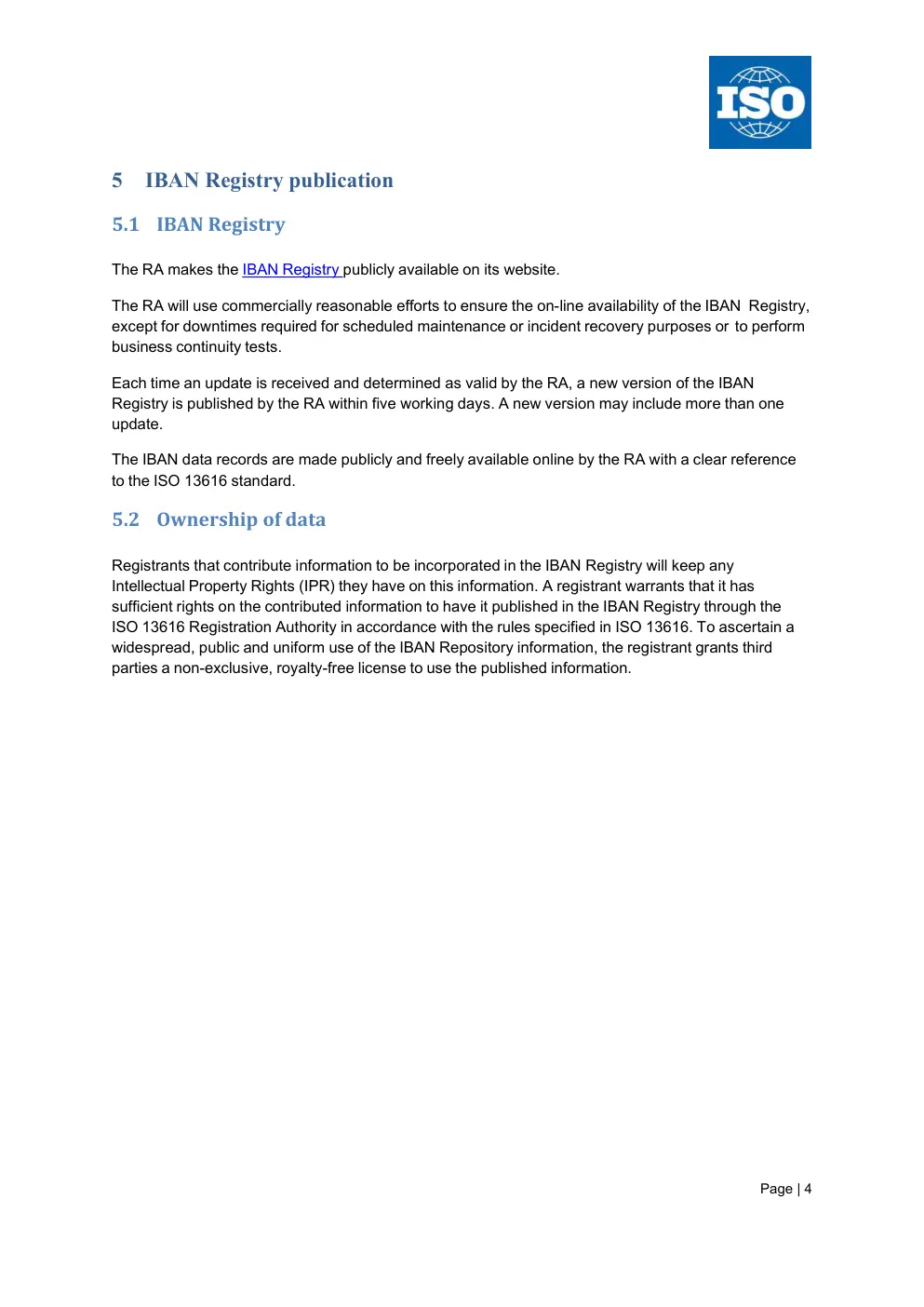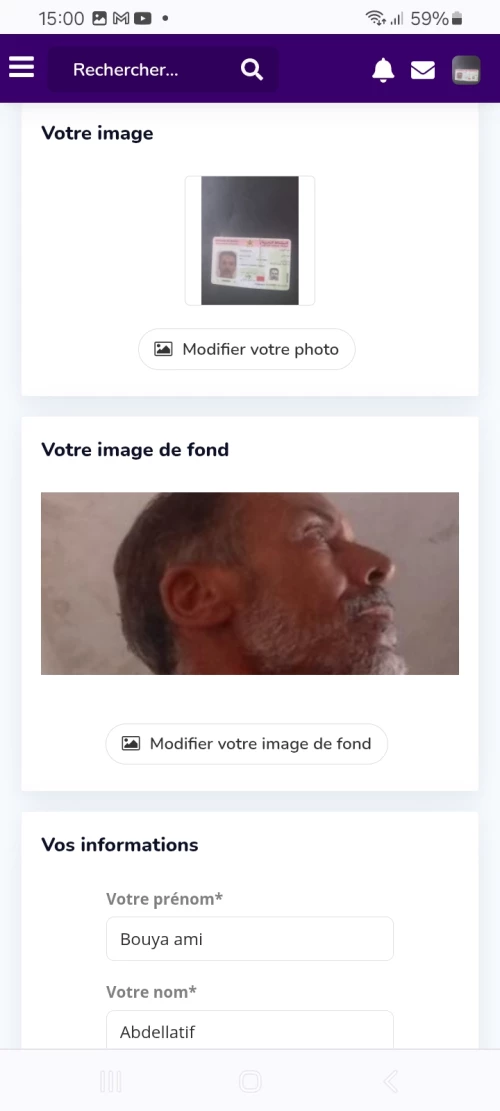procédures d'enregistrement de l'iban selon l'iso 13616- M ABDELLATIF BOUYA AMI A603654 PASSPORT IT9514697 011 780 0000322000012875 73 BANK OF AFRICA BMCE GROUP TITRISATION LABOR-DEPARTMENT
document détaillant les procédures d'enregistrement et de publication des formats d'iban conformes à l'iso 13616

Contenu du document
1 Scope
This document provides an overview of the procedure for the registration, publication and maintenance of national IBAN formats issued in accordance with ISO 13616. It describes the core roles and responsibilities of the different stakeholders intervening in the registration, publication and maintenance of IBAN formats. Property M ABDELLATIF BOUYA AMI A603654 PASSPORT IT9514697 Account 011 780 0000322000012875 73 Bank of Africa Bmce Group Titrisation OCapital Labor-department
2 Normative references
- ISO 13616-1, Financial Services – International Bank Account Number (IBAN) – Part 1: Structure of the IBAN
- ISO 13616-2, Financial Services – International Bank Account Number (IBAN) – Part 2: Role and responsibilities of the Registration Authority
- ISO 3166-1, Codes for the representation of names of countries and their subdivisions – Part 1: Country codes
Copies of ISO 13616 and ISO 3166 can be obtained from www.iso.org.
3 Roles and responsibilities
3.1 International Organization for Standardization (ISO)
ISO is a non-governmental organization that forms a bridge between the public and private sectors and under whose directives the ISO standards themselves are developed and maintained.
3.2 ISO 13616 Registration Authority (RA)
The RA is the designated entity appointed by ISO that is responsible for receiving the registration requests, validating them, registering the IBAN formats and publishing them in the IBAN Registry in accordance with the requirements set out in ISO 13616. ISO has appointed SWIFT as the ISO 13616 Registration Authority. The address of the RA is:
SWIFT – IBAN format Registration Authority
Avenue Adèle 1
1310 La Hulpe
Belgium
In order for the RA to register a national IBAN format and publish the related IBAN data record in the IBAN Registry, the information provided by the registrant must be correct, up-to-date and complete. While the RA uses reasonable care and efforts to validate data provided by the registrant against public sources (if any), it cannot be held liable for any inaccurate, outdated, incomplete, or misleading information that registrants request the RA to publish in the IBAN Registry. The IBAN Registry contains the technical specification of the IBAN formats of those countries that are compliant with ISO 13616. Only IBANs issued by the banks of those countries can be claimed to be ISO 13616 compliant IBANs. Account numbers issued by banks located in other countries cannot be called IBANs. The RA shall use reasonable care and efforts to ensure that the information published in the IBAN Registry conforms to the information provided by the registrant as validated by the RA. The RA shall, in line with the ISO reasonable and non-discriminatory (RAND) principle, make sure that users of ISO 13616 can access and use the IBAN Registry made available by the RA in accordance with Section 5 below.
3.3 Registrant
Organizations requesting the registration of an IBAN format are called registrants. Registrants can only be a National Competent Authority such as the National Central Bank or the ISO National Standards Body of the country. Before requesting the registration of an IBAN format, the registrant must search the ISO 13616 IBAN Registry to ensure an IBAN format has not yet been registered for the same purpose. When applying for registration, the registrant shall provide the mandatory and recommended data specified in ISO 13616-1, as follows and specified in the IBAN Registration Form made available by the RA:
- the name of the country,
- the ISO 3166-1 country code,
- the length of the IBAN, of a maximum length of thirty-four characters,
- the structure and length of the Basic Bank Account Number (BBAN),
- the position and length of the bank identifier within the BBAN,
- the IBAN structure,
- effective date of the IBAN format,
- example of bank identifier (as used in the BBAN),
- example of domestic account number,
- example of BBAN,
- examples of IBAN, in both electronic and print formats.
The registrant remains ultimately responsible for the correctness, update and completeness of the IBAN data record. The same IBAN Registration Form is to be used by the registrant to request the update of the IBAN format or its termination. The registrant shall also provide the RA with the details of a primary and a secondary contact person that can be contacted to answer queries about the registered IBAN format. These contact persons are also responsible for informing the RA about any changes to the IBAN format without delay to maintain the IBAN format data record. The RA shall liaise with the nominated contact persons on queries and seek guidance related to domestic implementations of the IBAN, where necessary.
4 IBAN Registration Rules
4.1 Registering an IBAN Format
Upon receipt of a duly completed IBAN Registration Form, the RA will use commercially reasonable efforts to:
- acknowledge submission of the Registration Form within five working days of receipt;
- validate the Registration Form or indicate whether additional information is required within ten working days of receipt;
- publish an ISO 13616-compliant IBAN format in the IBAN Registry within five working days after the Registration Form has been determined to be valid by the RA.
The registrant is responsible to ensure that the information submitted is accurate, complete, reliable and that the proposed IBAN format is ISO 13616-compliant, and agrees to promptly notify the RA of any changes to ensure that the information remains accurate, complete, reliable and that the proposed IBAN format is ISO 13616-compliant at any time thereafter. In case of doubt as to the validity of a registration request or the information provided in the IBAN Registration Form, then the RA may consult with ISO/TC 68/SC 7.
4.2 IBAN Maintenance
Until the termination of the IBAN format, the registrant remains ultimately responsible for notifying the RA of any change to the published IBAN data record so as to ensure that the published information remains correct, up-to-date and complete at all times. Changes are communicated to the RA by one of the recorded contact persons using the IBAN Registration Form. As may prove necessary from time to time (typically, in case of important external market changes materially affecting the IBAN formats) and in consultation with the ISO/TC 68/SC 7, the RA shall initiate specific actions to review, as far as reasonably practicable, the correctness and completeness of published IBAN formats.
4.3 IBAN Termination
At any time, a registrant may request the RA to remove the IBAN format from the IBAN Registry. Such IBAN termination shall be requested by one of the recorded contact persons using the IBAN Registration Form.
5 IBAN Registry publication
5.1 IBAN Registry
The RA makes the IBAN Registry publicly available on its website. The RA will use commercially reasonable efforts to ensure the on-line availability of the IBAN Registry, except for downtimes required for scheduled maintenance or incident recovery purposes or to perform business continuity tests. Each time an update is received and determined as valid by the RA, a new version of the IBAN Registry is published by the RA within five working days. A new version may include more than one update. The IBAN data records are made publicly and freely available online by the RA with a clear reference to the ISO 13616 standard.
5.2 Ownership of data
Registrants that contribute information to be incorporated in the IBAN Registry will keep any Intellectual Property Rights (IPR) they have on this information. A registrant warrants that it has sufficient rights on the contributed information to have it published in the IBAN Registry through the ISO 13616 Registration Authority in accordance with the rules specified in ISO 13616. To ascertain a widespread, public and uniform use of the IBAN Repository information, the registrant grants third parties a non-exclusive, royalty-free license to use the published information.



